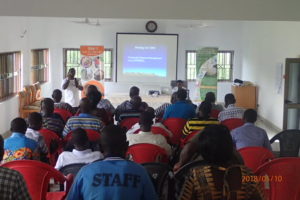Atewa CREMAs Trained in Community Natural Resource Governance
*CREMA means: Community Resource Management Area
Background

Atewa Range Forest Reserve
The Atewa Forest landscape besides its water provisioning functions sinks about 200,000 tons of carbon annually as well as provides an enabling micro-climate for agriculture which accounts for 9.2 million dollars as income from cocoa production only. Unfortunately, recent studies have shown that the closed forest canopy has decreased by 10% in the forest reserve and 35% in adjoining lands over the last 20 years. This major challenge can be attributed to inadequate law enforcement on the part of government regulatory agencies and a near non- existent community based natural resource governance structures.
As part of activities under the Community-led Resource Management and Governance project within the Atewa Landscape, 10 communities in the South Eastern boundaries have benefited from a training aimed at building the capacities of proposed Community Resource Management Committees (CRMC) on existing legal frameworks with respect to sustainable natural resource governance using the CREMA approach as established by the Wildlife Division of Ghana.
The training focused on strengthening the knowledge base of proposed CREMA communities on their legal rights and responsibilities and how to act accordingly to ensure sustainable resources management within their landscape. The workshops were organized in the East Akim Municipal Assembly Hall in Kyebi and the Ayensuano District Assembly Hall at Coaltar. A total of 104 Community Resource Management Committee (CRMC) representatives from the 10 communities participated in the training.
Highlights of the Training

Presenting on the threats and challenges to sustainable natural resource management in Ghana, Mr. Emmanuel Akom (Project Manager- Atewa landscape), took the opportunity to share recent findings from a soil and water quality analysis which was conducted by scientist within the Atewa landscape. Details of the research indicated that heavy metals such as Mercury, Arsenic and Lead found in the soils and water samples were beyond acceptable limits for consumption and this came about as a result of illegal mining methods which were used to exploit mineral resources such as gold.
Daniel Kwamena Ewur, the Collaborative Resource Management Officer for the Atewa landscape took the workshop participants through the legal and policy environment for collaborative resource & wildlife management and the CREMA Concept. He gave the Legislative Instrument (LI) 685 & 710 of 1971 as the main legal instrument which grants the wildlife division the authority to establish and protect conservation areas as well as wildlife in off-reserve areas. He again mentioned that, effective management of wildlife is best achieved by giving it a focused value; whiles those who live with and bear the cost of wildlife protection are made primary beneficiary of its management. He also highlighted the immense roles women can play in the protection of wildlife resources.

Group discussion on indigenous knowledge in resource governance-Kyebi training
In line with efforts to learn and incorporate indigenous traditional knowledge in resource governance within the Atewa landscape, participants were put in groups to deliberate and come out with customary resource management laws within their communities, analyze their effectiveness as well as inherent challenges to inform future local governance actions and measures.
Participants after the workshop commended the CREMA initiative and were ready to collaborate with the relevant institutions such as the Forestry Commission, Minerals Commission, Environmental Protection Agency, District and Municipal Assemblies and the Ghana Police Service in securing the future of Atewa Forest Reserve and the entire landscape.
Project is supported by: FFEM, PPI & IUCN France
Participating Communities: Akwadum, Owura, Twum, Potroase, Obuase, Odumase, Amanfrom, Obuoho, Akyeasa, Kwesi, Komfo and Okanta
